In this article:
Yoga is an amazing practice and lifestyle for people of all ages. However, the style of one’s practice changes depending on one’s age and specific needs.
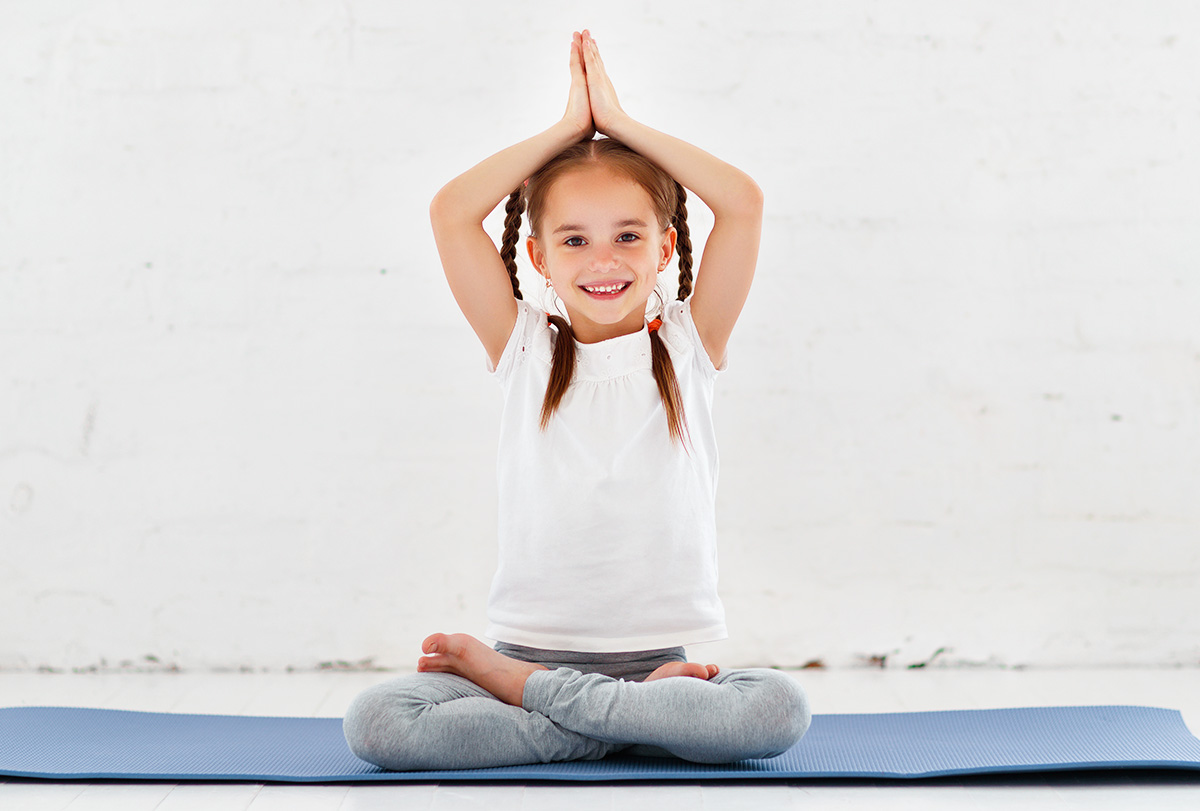
Children, in particular, can greatly benefit from a regular yoga practice for many reasons. These benefits include but are not limited to:
- Sensory input (1)
- Balance
- Release of excess energy (2)
- Helping with anxiety/depression
- Better sleep
- Focus
- Relaxation
- Stress reduction
- Better alignment of the body/posture
- Increased strength
Due to the many ways children can benefit from a regular yoga practice, some schools have begun to integrate yoga into their curriculum, programs, and philosophies. However, this change has only been made in a fraction of schools worldwide, and a lot of kids do not receive the opportunity to do and learn about yoga.
Yoga can be done outside of school as well, and children can also practice at home with family. (3) Doing yoga with parents is a great bonding experience for everyone involved and also gives kids some often needed one-on-one time.
For kids, yoga is very different from what it is for adults. While many are used to a quiet, calming, hour-long class, children cannot sit still for very long. Yoga can be done through storytelling, singing songs, dancing, (4) playing games, and even while watching yoga on TV.
There are many amazing yoga poses for children to do, and each kid is different. Therefore, some poses may benefit one child more than the others depending on the individual need.
Here is a list of 10 great yoga poses for kids to do:
- Easy sitting pose (Sukhasana)
- Child’s pose (Balasana)
- Half-lotus pose (Ardha Padmasana)
- Cobra pose (Bhujangasana)
- Wide-angle seated forward bend (Upavistha Konasana)
- Seated forward fold (Paschimottanasana)
- Butterfly pose (Baddha Konasana)
- Tree pose (Vrksasana)
- Warrior I (Virabhadrasana I)
- Corpse pose (Savasana)
Ten Yoga Poses for Kids
Each of the poses is amazing for all ages, and performing these together makes for a fun and enjoyable practice.
1. Easy sitting pose (Sukhasana)
The easy sitting pose is one of the easier poses to do, hence the name. It involves sitting up straight with the legs crossed; many kids know this as the “crisscross applesauce.”
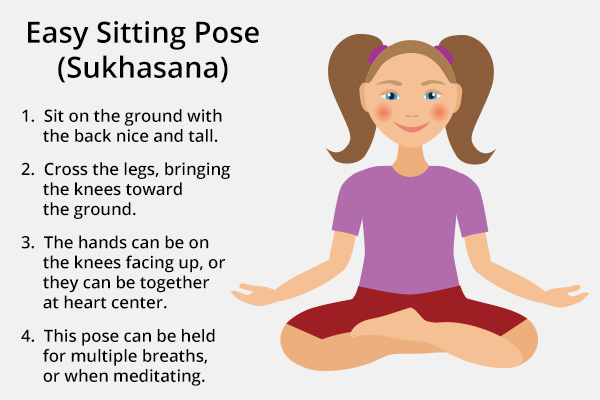
How to do this pose:
- Sit on the ground with the back nice and tall.
- Cross the legs, bringing the knees toward the ground.
- The hands can be on the knees facing up, or they can be together at heart center.
- This pose can be held for multiple breaths or when meditating.
Benefits of this pose include but are not limited to:
- Promoting relaxation
- Increasing focus
- Correcting posture
- Strengthening the muscles in the back
- Increasing flexibility in the hips and legs
- Decreasing stress
This pose can be practiced while taking deep, calming breaths or while focusing on a specific thought or image.
2. Child’s pose (Balasana)
The child’s pose is another simple pose to do, and it involves sitting back on the heels and folding forward, bringing the arms out in front of the body, and resting the forehead on the ground. By curling up like this, one can feel held.
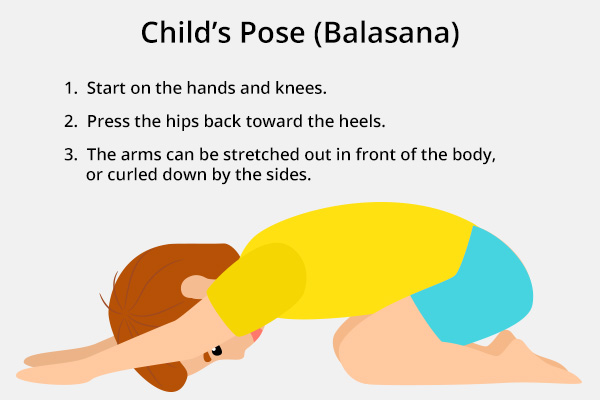
How to do this pose:
- Start on the hands and knees.
- Press the hips back toward the heels.
- The arms can be stretched out in front of the body or curled down by the sides.
Benefits of this pose include but are not limited to:
- Promoting relaxation
- Reducing stress
- Grounding oneself
- Calming oneself
- Increasing flexibility and strength in the ankles, legs, and hips
- Releasing tension from the body (specifically the upper body)
This pose mimics what it feels like to be in the womb. Therefore, for a child, this pose is incredibly comforting and grounding. This pose is also helpful in settling down a child when they are overwhelmed, upset, or hyper, but it can also be used just for relaxing in general.
3. Half-lotus pose (Ardha padmasana)
The half-lotus pose is an easier version of the lotus pose, but it still provides the advantages of the full pose. It is important to note that this pose should be done on both sides of the body to get equal results on each side.
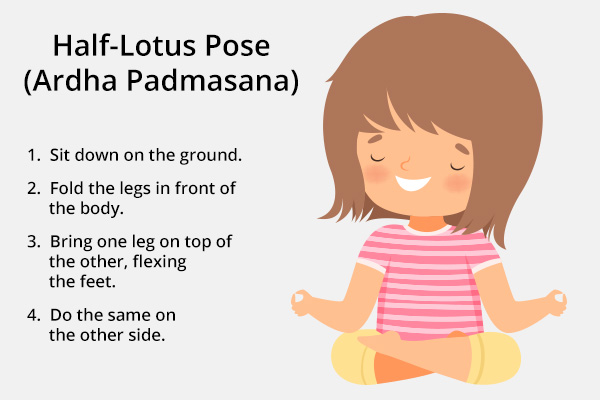
How to do this pose:
- Sit down on the ground.
- Fold the legs in front of the body.
- Bring one leg on top of the other, flexing the feet.
- Do the same on the other side.
Benefits of this pose include but are not limited to:
- Promoting relaxation
- Grounding oneself
- Increasing creativity
- Strengthening awareness
- Increasing flexibility in the hips and legs
- Correcting posture
- Releasing tension from the body (specifically the upper body)
This pose can be done while pretending to be a flower, making it creative and exciting for kids. One can pretend that roots are going down through the legs into the earth while growing into a flower and “blooming.”
4. Cobra pose (Bhujangasana)
The cobra pose is a very fun pose that includes laying on the belly, bringing the hands flat to the ground beneath the shoulders, and straightening the arms just enough to lift the chest up.
When doing this pose, one should make sure to only press up as far as one can go using the muscles in the back. This prevents overextending and keeps the body safe.
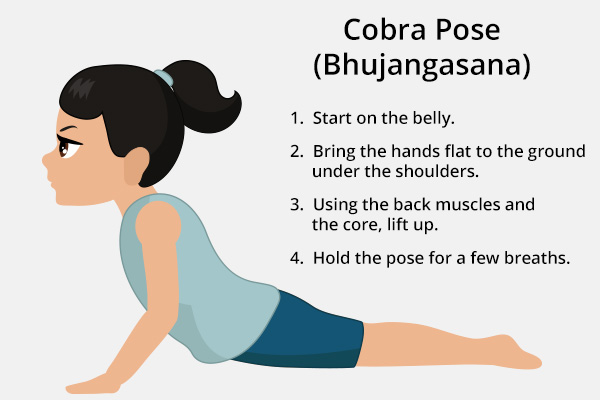
How to do this pose:
- Start on the belly.
- Bring the hands flat to the ground under the shoulders.
- Using the back muscles and the core, lift up.
- Hold the pose for a few breaths.
Benefits of this pose include but are not limited to:
- Increasing positivity
- Decreasing stress
- Strengthening the muscles in the chest, arms, and back, and abdomen
- Increasing creativity
- Strengthening awareness
- Correcting posture
- Reducing fatigue
- Promoting proper circulation
A fun way to do this pose is for one to lie on the ground with the hands flat, take a deep breath in, and then press up into the cobra pose while hissing like a snake. This is a very fun way for kids to practice this exercise, and it usually ends with lots of giggles.
5. Wide-angle seated forward bend (Upavistha konasana)
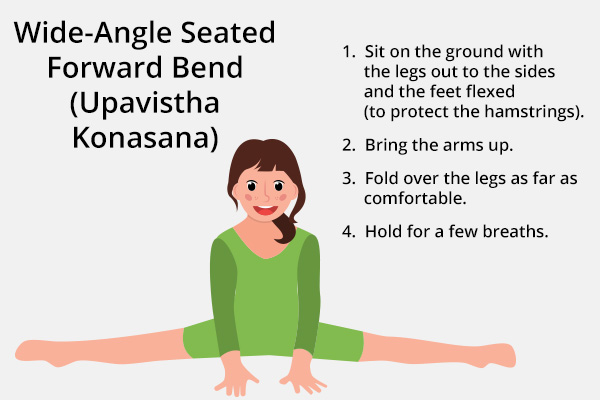
How to do this pose:
- Sit on the ground with the legs out to the sides and the feet flexed (to protect the hamstrings).
- Bring the arms up.
- Fold over the legs as far as comfortable.
- Hold for a few breaths.
Benefits of this pose include but are not limited to:
- Strengthening muscles in the core and spine
- Increasing flexibility in the legs and hips
- Correcting posture
- Improving digestion
- Decreasing frequency of belly aches
- Promoting relaxation
Another fun way to perform this wide-angle seated forward bend is as a team. To do this stretch, two people can face each other, bringing the feet out to the side and touching them together. Both people can then join hands and carefully take turns pulling each other deeper into the pose. As one person leans forwards, the other leans back.
6. Seated forward fold (Paschimottanasana)
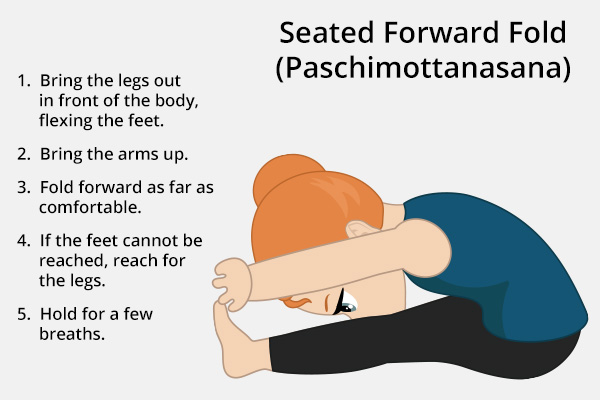
How to do this pose:
- Bring the legs out in front of the body, flexing the feet.
- Bring the arms up.
- Fold forward as far as comfortable.
- If the feet cannot be reached, reach for the legs.
- Hold for a few breaths.
Benefits of this pose include but are not limited to:
- Promoting relaxation
- Decreasing stress
- Improving digestion
- Decreasing frequency of belly aches
- Decreasing anxiety
- Relieving headaches
- Reducing fatigue
The seated forward fold is similar to the wide-angle seated forward bend. The difference, however, is that instead of having the legs out to the sides, the legs are out in front of the body, creating a much different stretch.
7. Butterfly pose (Baddha konasana)
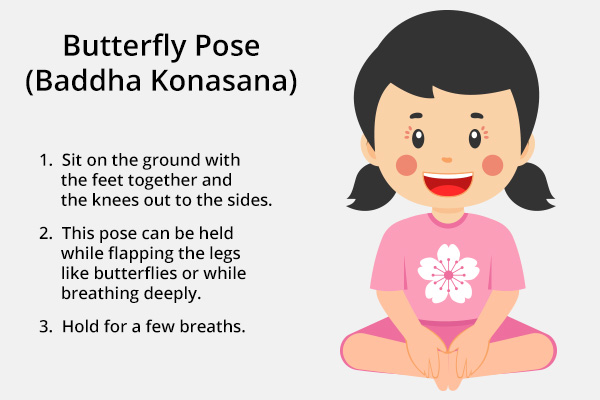
How to do this pose:
- Sit on the ground with the feet together and the knees out to the sides.
- This pose can be held while flapping the legs like butterflies or while breathing deeply.
- Hold for a few breaths.
Benefits of this pose include but are not limited to:
- Promoting creativity
- Strengthening the muscles in the legs and abdomen
- Improving digestion
- Decreasing anxiety
- Calming oneself
- Relieving headaches
- Reducing fatigue
- Grounding oneself
The butterfly pose is very popular with kids. It allows for super fun bonding experiences, especially between parents and their kids. By sitting with the feet flat together and the knees out to the side, the child can flap their knees up and down like wings and tell a story or imagine flying.
8. Tree pose (Vrksasana)
The tree pose is often a favorite among children. While challenging, the pose has many variations, making it accessible for people of all ages and abilities.
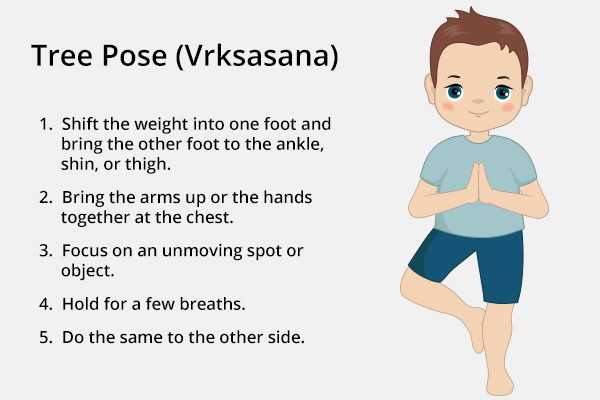
How to do this pose:
- Shift the weight into one foot and bring the other foot to the ankle, shin, or thigh.
- Bring the arms up or the hands together at the chest.
- Focus on an unmoving spot or object.
- Hold for a few breaths.
- Do the same to the other side.
Benefits of this pose include but are not limited to:
- Promoting creativity
- Strengthening the muscles in the legs, hips, glutes, and core
- Promoting balance
- Providing sensory input
- Correcting posture
Kids love to turn this pose into a competition to see who can hold it the longest. A fun way of practicing the tree pose is to imagine roots coming down from the feet in the ground and to lift the arms to create “branches.”
9. Warrior I (Virabhadrasana I)
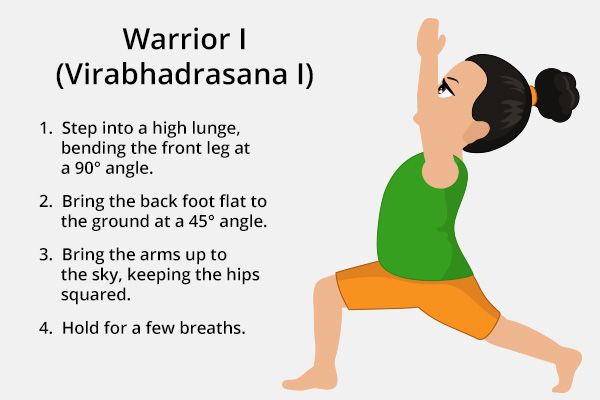
How to do this pose:
- Step into a high lunge, bending the front leg at a 90° angle.
- Bring the back foot flat to the ground at a 45° angle.
- Bring the arms up to the sky, keeping the hips squared.
- Hold for a few breaths.
Benefits of this pose include but are not limited to:
- Strengthening the muscles in the legs, hips, chest, arms, and back
- Promoting balance
- Providing sensory input
- Correcting posture
- Increasing circulation
- Increasing focus
- Decreasing stress
- Reducing anxiety
- Promoting calmness and meditation
While all of the warrior poses are fun to practice, warrior I in particular emphasizes balance, strength, and focus. Therefore, it is a great pose to do with kids.
10. Corpse pose (Savasana)
The corpse pose is a very simple pose to do and just involves lying flat on the ground with the arms by the sides and the legs straight out in front of the body. This is usually when one meditates during a yoga practice.
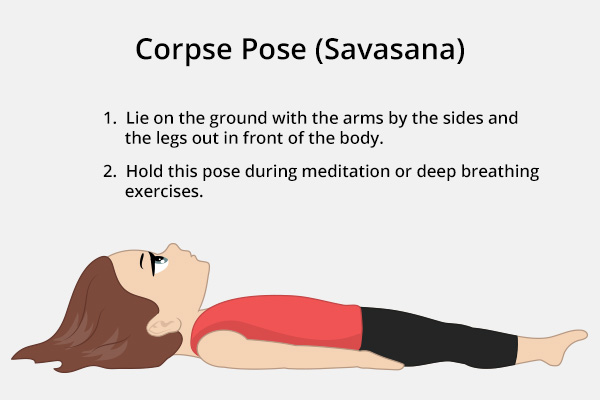
How to do this pose:
- Lie on the ground with the arms by the sides and the legs out in front of the body
- Hold this pose during meditation or deep breathing exercises.
Benefits of this pose include but are not limited to:
- Promoting creativity
- Decreasing anxiety
- Promoting relaxation
- Calming oneself
- Grounding oneself
- Increasing focus
There are lots of online meditations for kids, but they can also create their own by thinking of a fun or happy place and focusing on everything that is seen there.
What Science Says About Yoga for Kids
Studies have been done to see the effect that yoga has on children. The practice has been proven to increase focus and decrease anxiety when it comes to schoolwork and studying. (5) It has also been found to promote mindfulness for kids who do yoga regularly. (6)
These studies have also shown that practicing yoga is associated with decreased violence in schools by providing a way for kids to release pent-up energy, stress, and anger. (7)
Yoga is a powerful tool for children and teenagers to have as they face the stresses of school, social drama, and peer pressure, among other challenges.
Final Word
Yoga involves practicing balance and giving heavy sensory input. This is why it is a great tool for kids who have sensory processing disorders. The sensory benefits of yoga, in particular, make it useful for children on the autism spectrum.
There are many advantages to beginning a yoga practice at an early age. It provides a strong foundation for a child to have as they grow up.
Download the Printable Image from Here – 10 Yoga Poses for Kids
- Was this article helpful?
- YES, THANKS!NOT REALLY


